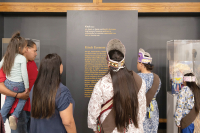Last man standing: Waynesville makes history with an untidy ending to an untidy war
 Union Col. William Bartlett tried to keep his cool as he watched his bitter, battle-hardened Confederate enemies riding down Main Street that May morning of 1865.
Union Col. William Bartlett tried to keep his cool as he watched his bitter, battle-hardened Confederate enemies riding down Main Street that May morning of 1865.
SEE ALSO:
• Like a Good Neighbor: The Eastern Cherokee and the Confederacy
• Take a Civil War tour in Haywood County
• The Fall of Will Thomas
• Civil War commemoration attracts history fans
• Bringing the past to life
• ‘Last Shot Fired’ — Civil War 150th anniversary commemoration
They were flying a white flag, but the town was like a tinderbox waiting to spark. Union men had occupied Waynesville the day before, but Confederate militia were rallying in the hills, ready for blood if the parley wasn’t fruitful.
The war was over everywhere else, but the Confederates holed up in far western mountains weren’t going quietly. They’d dug in, ready to make a stand rather than stand down — witnessed by the poor Union sap who’d taken a bullet the day before when a fired-up band of Confederates made it clear that to them, the war wasn’t over, and Bartlett and his Union men best head back out of town.
Now, Bartlett was in a bit of a predicament. He was part of the Union mop-up crew, assigned to stamp out the Confederate insurgents in the mountains who were too isolated to know the war was over, or just too proud to admit it — or perhaps a bit of both.
They’d mobilized every man they could muster to guard the mountain gaps and stop Union troops from punching through this final Confederate stronghold of the South.
Related Items
Bartlett was supposed to root them out and secure their surrender. But instead, the Union colonel got surrounded in enemy territory, and no one was quite sure what would happen next.
Bartlett waited in the front yard of the Battle House inn, which was doubling as his command post, as the riders approached. He looked past Confederate Gen. James Martin who was riding in the lead and instead trained his eyes on the man behind him, Will Thomas.
Thomas led a fierce and fiercely loyal legion made up of mountain men and Cherokee Indians — known officially as the Legion of Indians and Highlanders — who had proved their mettle time and again during the war (See article on page 7).
True to form that day, Thomas was flanked by bare-chested Cherokee men in war paint and feathers, and for good measure was shirtless himself. The imagery — a calculated bit of psychological warfare — was working, especially on the heels of last night’s antics.
Mountains role in shaping history
It’s no accident that the South’s last stand in the Civil War happened here in the mountains — the steepest, tallest, most rugged mountains of the Southern Appalachians.
The high, craggy ridges were like giant castle walls. Small bands of troops could batten down the whole region simply by defending a handful of narrow passes.
“It is hard to get an army across the top of the mountain,” said Jule Morrow, a Civil War buff in Waynesville and descendent of Haywood’s most famous Confederate leaders.
Confederate Gen. James Martin had fortified the Balsam Mountains with men from Thomas’ Legion, but like his Union counterpart on Main Street that May morning, Martin was in a predicament too.
He suspected the war might be over, but he didn’t know for sure.
Gen. Robert E. Lee had surrendered his Confederate Army to Gen. Ulysses Grant at Appomattox Courthouse a full month earlier. And the rest of South had been falling steadily ever since.
But he certainly didn’t know that by now, Thomas’ Legion entrenched in the hills around Waynesville were the last men standing in the Confederacy.
Martin had been driven from Asheville two weeks earlier, in late April. He faced the same quandary then: fold or muster a defense of the city?
Meanwhile, troop morale under Martin’s command was waning badly. Some no longer wanted to be fighting, and some had never really wanted to fight in the first place.
“You had a bunch of guys who don’t really want to be there,” Morrow said. “They wouldn’t fight. They just refused. But by the same token they had heard other Confederate generals were surrendering.”
The only men Martin could still count on were Thomas’ Legion. He dispatched Col. James Robert Love from Waynesville and a team of roughly 250 mountain fighters to stop Union troops from passing through Swannanoa Gap. Love’s men felled a tangle of trees in the gap, and then set up an ambush, firing at the Union men as they tried to pick their way through the tree-strewn pass.
It worked, but it didn’t save Asheville. The Union made a wide flank to the South and came up through Hendersonville, taking the city in the end.
But Love’s display would ultimately come in handy during his standoff against the Union in Waynesville two weeks later.
“He shows how determined he is to fight,” Morrow said.
When Asheville fell, most of the troops under Martin’s command surrendered. But Martin himself and the men from Thomas’ Legion retreated to Waynesville and hatched a new plan to hold the more westerly mountains.
Waynesville would be hard to protect. It had too many valleys leading into it to protect easily. But the Balsam massif just beyond Waynesville was high and steep with few passes, making it easy for just a small number of men to mount resistance.
A band of 250 men trenched in at Balsam Gap and another 250 made camp at Soco Gap, with smaller units scattered across gaps from Mount Sterling to Newfound to Franklin — using the mountains to create a defensive ring of protected territory.
‘Everything was walk or ride a horse’
Days passed, however, and no Union troops showed up. All the while, Martin was trying to make contact with the outside world to know what his next move should be.
“He still hasn’t heard anything from the Confederate government and he is desperately trying to find out what to do,” Morrow said. “Like a good soldier, he has to take direction from the politico. Here in the west we had heard Lee had surrendered but we had no confirmation from the Confederate government.”
To be fair, the end of the war was a muddy affair. There was no singular, tidy handshake or stroke of the quill pen that declared the whole thing done.
Instead, a string of surrenders by various armies and generals played out in haphazard fashion — like a series of falling dominoes from Virginia to Mississippi — over a four-week span.
Martin had been isolated in Asheville, however, and now even more so — surrounded on all sides by Union territory. The train didn’t reach the mountains yet — it only went as far as Morganton.
“They didn’t have all this fast stuff they had today. You are too young to realize how slow stuff was back then,” said Hattie Caldwell Davis, a well-known author, historian, cultural heritage expert and of all things Haywood County. “Everything was walk or ride a horse if you could get one.”
Further complicating things, Confederate President Jefferson Davis had gone into hiding and was on the run, hoping to escape a certain sentence of treason.
The same was true of other Confederate cabinet members who were “haulin’ ass” after the fall of Richmond to various safe havens through the South, Morrow said. The Confederate cabinet themselves had been unable to decide on the question of the hour that now haunted Martin.
“Are we going to continue on as a guerilla war or what are we going to do?” said Morrow, a semi-professional Civil War re-enactor. “Martin tries to find out.”
He sends two Confederate officers from Thomas’ Legion in Waynesville — William Stringfield and Matt Love — over to Tennessee with a white flag to ask around.
“But they are captured and arrested so the word doesn’t get back to Martin,” Morrow said.
Martin heads to Franklin himself, wondering if the southern end of the Confederate inholding had any word coming up from Georgia, but no luck.
His suspicions were growing, however, especially when discharged Confederate soldiers who’d been serving under Lee began to show up in the mountains.
“About the time the Battle of Waynesville is getting ready to happen, the home guard starts picking up guys who had been surrendered in Virginia and were making their way back home,” Morrow said. “Martin even starts interviewing some of these guys that have come in.”
Ultimately, Martin wouldn’t learn the news he was looking for until he met face-to-face with Union Col. Bartlett on Main Street.
When the home front is the frontline
While Martin searched for answers, Thomas Legion remained in a holding pattern in the Balsam Mountains beyond Waynesville.
The Union couldn’t let a Confederate general and his band of rebels stay holed up forever, refusing to come out and surrender.
“They were trying to destroy any remnants of the Confederate army,” Morrow said.
And so eventually, the Union sent Col. Bartlett to clean out the renegade Confederates. Bartlett was lulled by false sense of security when he rode into Waynesville on May 6, finding nary a Confederate in sight, not realizing of course they were strategically fortified in Balsam Gap and Soco Gap.
“Waynesville falls really easily to Bartlett, but that was part of the plan,” Morrow said.
No doubt the Union soldiers were hoping to be unleashed for a little looting. Union troops across the South were on plundering sprees, and the rank-and-file Union soldiers under Bartlett’s commend would feel cheated if they didn’t return home with loot, Morrow said.
“That was kind of the way war used to be played. You kind of had to let them get some loot,” Morrow said.
But to officers, the raids had another purpose: a calculated nail in the coffin. Ransacking communities ensured that any insurgents with a mind to regroup and keep on fighting would be properly demoralized and forced to direct their energy to rebuilding.
But the Union men under Bartlett had only gotten table scraps so far, always showing up on the tail end of the sacking.
“Bartlett’s guys, they’ve never really had a good looting. All the good pickin’s was already taken,” Morrow said.
Union troops had stepped up the use of ransacking as a tool of warfare across the South starting in early 1865.
“They had to tire them of the war. They had to make the home front so bad the women would be writing to the men saying ‘Come home. I can’t do this,’” Morrow explained.
Union troops swept the mountains around Boone in March, during a campaign known as General Stoneman’s Raid that had sacked and pillaged its way down into the Piedmont.
Waynesville had been hit a month earlier, in February 1865, by a band known as Kirk’s Raiders who routinely slipped over the state line from Knoxville. Raiding was Col. George Kirk’s official job for the Union, in fact, with a sanctioned guerilla army at his disposal for the cause.
When Kirk’s Raiders descended on Waynesville for a full-scale attack in February 1865, they didn’t stop with the usual fare of snatching chickens, stealing horses and pilfering homes for provisions.
They swept through downtown, burning key buildings, including the house of Waynesville’s founder, Robert Love, the father of Confederate Col. James Robert Love who was part of Thomas’ Legion.
They sprung everyone held in the county jail, who were mostly Union prisoners at the time, and then they made their way up Main Street to William Welch’s house, a prominent townsmen whose seven sons all fought for the Confederacy.
Kirk’s Raiders carried Welch and his wife out of his house to torch it.
“When they got ready to fire the house, one of Kirk’s men pulled his pistol out and said he would kill the first man who tried to burn Mr. Welch’s house and turned to Kirk and said, ‘Then I’ll kill you,’” Morrow said.
Morrow suspects it was a man from Haywood County who’d taken up on the Union side.
“Apparently, they believed he’d do it,” Morrow said. And so they moved on, sparing Welch’s house, which stood across from the Battle House.
With men away at war, civilians were usually helpless and vulnerable to these sprees. But Kirk’s Raiders got a run for their money as they tried to flee back to Tennessee.
“They barely made it out with their hides,” Morrow said.
Small detachments of Thomas’ Legion ambushed them first at Balsam Gap, diverting their escape route to Soco Gap where they were ambushed again. Legend has it the men in Thomas’ Legion ran out of ammunition, otherwise they would have finished Kirk’s raiders off.
When Union troops finally marched into Waynesville in May of 1865, memories of that raid just three months earlier were still fresh, and Thomas’ Legion was resolved to keep it from happening again.
They also heard of the ruinous and violent pillaging that had ravaged nearby Asheville by unruly Union soldiers on the way out.
Now, Thomas’ Legion was the last chance at saving Waynesville from a similar fate.
“When they found out how Asheville was sacked, they were mad and ready to fight,” Morrow said.
Raising a legion
The fear of raids haunted the people of Western North Carolina during the Civil War. Here on the frontline of Union territory, they lived in constant terror of snatch-and-grab raiders coming over from Tennessee.
The threat from Union lines in Tennessee was partly what motivated Thomas, an adopted white son of the Cherokee who rose to wealth and political prominence, to form his legion in the first place.
The Legion of Indians and Highlanders was raised to “defend the passes in the Smoky Mountains” from Union incursions, Thomas wrote in his own words.
But Thomas’ Legion was called away to other Civil War campaigns in 1863 and ‘64, ultimately losing 80 percent of the men it started with.
“These were a battle-hardened, tough bunch of guys,” Morrow said, rattling off battles like Sharpsburg, Winchester, Monocacy, Cedar Creek and others they had under their belt. “They had been in constant fighting in a pretty tough campaigns.”
It wasn’t until late 1864 that the war-torn and tattered Legion was released to back to the mountains.
But emotionally they were still “full of fight” and intent on protecting their home turf.
“Even though they lost a lot of men, they were still a pretty formidable force — 600 to 800 Cherokee warriors and mountain men who knew the area. They were guerilla warriors, assigned to protect all of Western North Carolina,” said Daniel Asnip, who grew up in Waynesville hearing the local lore of the Battle of Waynesville, and later researched it for a history thesis in college at UNC-Asheville.
The last battle
Morrow wagers there were no more than 500 Union troops under Col. Bartlett when they rode into Waynesville 150 years ago this week.
Some accounts claim they camped about a half-mile from downtown, in a low-lying field along Richland Creek off present-day Sulphur Springs Road. But Morrow doesn’t think so. And this is where his own role-playing as a Civil War re-enactor gives him insight an academic historian doesn’t have.
In the Civil War, it was common to have small outposts of men stationed around the main camp — essentially serving as sentinels. It was called “being on picket.”
“You send guys about a quarter mile out from the main camp in all directions,” Morrow said.
Meanwhile, a small band of riflemen with Thomas’ Legion — a specialized team known Conley’s Sharpshooters — were patrolling Waynesville when they staggered upon the soldiers on picket at Sulphur Springs.
Conley hollered at them to form a line and fire. They shot their muskets once, and then charged at the surprised Union soldiers with their bayonets drawn, sending them running back toward downtown.
And so went the Battle of Waynesville.
“The number of shots fired in Waynesville was probably one volley and was done by skirmishers of no more than 25 guys,” Morrow said.
But a Union soldier was fatally shot in the volley, making the altercation true to its fame.
“The last shot fired in anger in the Civil War east of the Mississippi was indeed fired right here in Haywood County,” Asnip said.
Meanwhile, the news that Union troops had rolled in to Waynesville was quickly carried back to the Confederate camps at Balsam Gap and Soco Gap.
They quietly left their high mountain posts and began to close in on Waynesville.
Come nightfall, in a clever bit of stage theatrics, they built a ring of bonfires on the ridges and hillsides circling Waynesville.
“Thomas had them beating drums and doing war chants and battle cries down into the valley to terrorize the Union forces quivering in their tents,” Asnip said.
The next morning, Confederate Gen. Martin and the famed Will Thomas rode into downtown for a parley with the occupying Union officer Col. Bartlett.
As they converged in front of the Battle House, they both demand each other’s surrender.
Bartlett explained he couldn’t surrender because the Union had already won. But Thomas countered with a trump card.
Thomas informed the Union occupiers that the hills of Waynesville were surrounded with his Cherokee fighters, and they frankly didn’t care if the war was over or not.
“Thomas threatened to bring his Indians in and scalp the whole crowd, every last Union soldier in Waynesville,” Morrow said.
The stage, of course, had been set perfectly. A Confederate soldier dressed in plain clothes had slipped into town the day before and begun spreading rumors about the size of Thomas’ Legion amassing in the hills.
The bonfires and war whooping through the night had properly put them on edge. And now he was face-to-face with a shirtless Thomas, whose reputation needed no introduction.
Bartlett weighed his options carefully. There was a chance — a real chance — those Cherokee warriors and mountain men were hiding out in the hills, waiting to bum rush the surrounded Union troops.
For Thomas, the act wasn’t entirely an act. He was every bit the wild cannon he claimed to be. Thomas was already suffering from the early stages of what was most likely Alzheimer’s. Within two years, he would be declared insane and committed to a mental asylum.
It was now up to Martin to broker a truce. He offered Bartlett a deal: Thomas’ Legion would surrender, but they would write their own terms, which were ultimately the most generous terms of any Confederate surrender in the war.
The Confederates were allowed to keep their guns and simply go home. But most of all, there would be no pillaging. Bartlett pledged to take his men and pull out of Waynesville promptly, and leave the western mountains be.
Meanwhile, Gen. Martin sent riders to tell the detachments guarding various gaps — from Cowee near Franklin to Newfound near Cherokee to Mount Sterling. The war was over.
No one will ever know for sure whether the Confederate officers in Thomas’ Legion believed their own tale: that they didn’t know the war was over.
It was certainly convenient to their strategy.
“We didn’t know the war was over so basically we couldn’t really stand down,” Asnip said.
Asnip, for one, believes it’s plausible.
“They probably heard rumors things were winding down but they had been trying to fight for the cause for so long, and they were soldiers, so it was hard for them to just give up. They didn’t really want to do that if there was a chance the Confederacy might be intact,” Asnip said.
There was a silver lining, which may have been the secret motive behind the Battle of Waynesville all along.
The far west was spared of the Union plundering that ravaged the rest of the South as the war drew to a close 150 years ago.
“Moving them on out of here helped,” Morrow said, crediting Thomas’ Legion for reversing the certain fate at the hands of the Union encampment.
In the end, it was mountain cunning, not armaments and forces, that wrote the history of the Confederacy’s last stand.
“Remember don’t nobody want to be the last fella killed in a war,” Morrow said.













